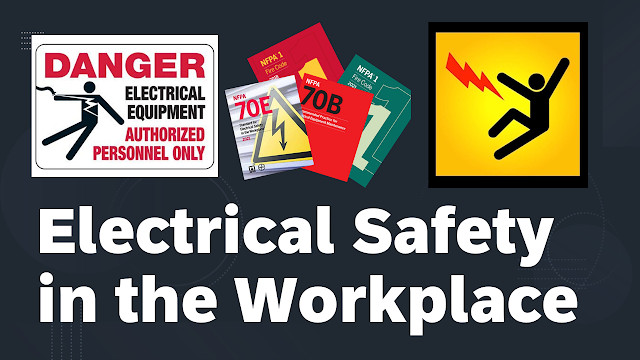The Importance of Electrical Safety in the Workplace
Introduction:
In today's modern world, electricity is an integral part of our daily
lives, especially in the workplace. While electricity powers our equipment and
facilitates productivity, it also poses significant risks if not handled with
care. Workplace electrical safety is of paramount importance to protect
employees from electrical hazards and prevent accidents that can result in
injuries, property damage, or even fatalities. This article explores the
importance of electrical safety in the workplace and highlights the key
measures that organizations should take to ensure a safe working environment.
Industrial Workplace Safety | Slip Trip Fall
Preventing Workplace Accidents:
Electrical accidents in the workplace can lead to severe consequences, including electric shocks, burns, and electrocutions. These accidents can result from various factors, such as faulty equipment, inadequate maintenance, improper use of electrical devices, or the absence of safety protocols. By prioritizing electrical safety, organizations can significantly reduce the risk of accidents and promote a secure working environment.
Employee Safety:
The well-being of employees should always be a top priority for
employers. Implementing electrical safety measures helps protect workers from
harm and ensures their physical and mental well-being. Proper training and
awareness programs can educate employees about potential electrical hazards,
safe work practices, and the proper use of electrical equipment. Employees
should be encouraged to report any electrical issues or concerns promptly to
ensure timely maintenance and repairs.
HEIGHT WORK SAFETY PRECAUTIONS
Risk Management:
Electrical safety is not only crucial for employee well-being but also for effective risk management within organizations. A workplace that prioritizes electrical safety reduces the likelihood of accidents, injuries, and property damage. This, in turn, helps minimize business disruptions, medical expenses, insurance claims, and potential legal liabilities. By implementing robust electrical safety policies, organizations can safeguard their employees and protect their assets.
Compliance with Regulations:
Adhering to electrical safety standards and regulations is not only a legal
requirement but also a moral obligation for employers. Government authorities
and regulatory bodies set guidelines and standards to ensure workplace safety.
Organizations must comply with these regulations, including electrical code
requirements, regular inspections, and maintenance checks. By meeting these
standards, employers demonstrate their commitment to providing a safe and
secure work environment.
FREE - MANUAL HANDLING TRAINING MODULE
Fire Prevention:
Electrical malfunctions are one of the leading causes of workplace fires. Faulty wiring, overloaded circuits, or improper use of electrical equipment can all contribute to the ignition of a fire. Implementing electrical safety measures, such as routine inspections, equipment maintenance, and proper storage of flammable materials, can significantly reduce the risk of fire incidents. Regular training and drills on emergency procedures further enhance the preparedness of employees in case of a fire.
Proactive Maintenance:
Regular inspection, testing, and maintenance of electrical systems and
equipment are essential to ensure their safe operation. Employers should
establish a preventive maintenance program that includes periodic checks,
repairs, and replacements of faulty or outdated equipment. This proactive
approach helps identify potential hazards before they escalate into dangerous
situations, safeguarding both employees and the organization's infrastructure.
Conclusion:
Electrical safety in the workplace is crucial for protecting employees,
preventing accidents, and promoting a secure working environment. Employers
should prioritize electrical safety by implementing comprehensive safety
programs, providing regular training, complying with regulations, and
conducting proactive maintenance. By investing in electrical safety,
organizations not only mitigate risks but also demonstrate their commitment to
the well-being of their employees. Remember, a safe workplace is a productive
workplace.





No comments:
Post a Comment